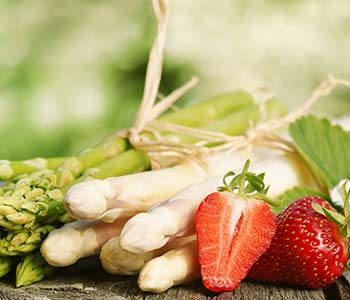
Why eating according to the seasons also makes us happy
There are many reasons why seasonal fruit and vegetables from the region are the better choice. One weighty argument is the lower environmental impact. Another is that we are gifted with more aromatic fruit and thus better quality. And a third is that when our patience is finally rewarded, we are thanked with happy hormones.
June 2021
Figures from: Berners-Lee, Mike (2020). How Bad are Bananas? Der CO2-Abdruck von allem. London: Profile Books Ltd.
Quicktranlation with DeepL
Asparagus season at last! Isn't it wonderful! For weeks we wander around the imported asparagus spears from first Peru and then Italy and remain persistent. Then, when the local ones finally hit the shelves, we pounce! A moment of happiness at the first bite. Moments of happiness, too, when it's "strawberry time! cherry time!" Valuable periods of time that need to be savoured and that end far too quickly. A plea for seasonal eating.
Can you remember when we were children, in the 1970s or 1980s, when many things were not yet a matter of course on the shelves all year round? Of the anticipation when the cherries slowly ripened on the trees and you spat out some half-green, hard and sour ones again because you couldn't wait? And finally, when it was finally time, that delicious moment! Moment of pause, of melting away, of palate pleasure. A moment that is controlled by the brain - with messenger substances from the neuronal reward system. The happiness hormone dopamine plays a central role. It is released in advance, in anticipation. When a goal is near and a desire or the immediate prospect of reward motivates us to act. Like when we observe the other person eating a mousse-au-chocolat cake with relish and we are about to order one from the waiter. Or when we are wandering around the imported asparagus spears, but don't put them in the shopping basket in anticipation of the domestic ones. When we finally experience the pleasure of fulfilling our desire, our body's own opiates are released, including endorphins and other messenger substances such as oxytocin.
Longing, desire and satisfaction motivate action. And the longer we wait for something and delay gratification, the more tempting and delicious the forbidden fruit becomes. And the more neurotransmitters our neural nervous system releases only in anticipation and consequently in satisfaction. The thrill of the first local and fully ripe cherry in June! Yay! Our hormones are dancing the salsa. We should keep that in mind. Exclusivity also in the sense of time limitation. How to learn to savour these moments in particular, by the way, can be read in this recommendable German article »Die kleine Schule des Genießens« (The little school of enjoyment) by psychologist Michaela Stark. Attention training for our senses.
More aromatics – in the right place at the right time. How much better, more aromatic and fruity do cherries, strawberries, apricots or tomatoes, and yes asparagus too, taste when they are harvested at the right time and in the right place. In our regional surroundings. When they are not transported across the globe in refrigerated containers. Harvested unripe, so that they survive the journey. And consequently can never develop their true strength, their given aromatic deliciousness, but are preserved by irradiation and chemical treatment, often produced under questionable conditions. Therefore: Only when the strawberries are ripe at home are they good. Full stop. After that, we just look forward to next year. Isn't that nice!
Finally, the eco-balance. Every person, every good, every foodstuff has an ecological footprint. This is made up of their land consumption and their CO2 footprint1. The latter is what we are talking about here, life is complicated enough. These figures speak volumes. See also footnote2, the weight of CO2 put into perspective.
- Asparagus 250 g
0,27 kg CO2e regional during the season
4,7 kg CO2e by air freight from Peru
For 1 kg, the emissions for air freight are approximately 100 times higher than by sea freight
- Tomatoes 1 kg
1,3 kg CO2e large salad tomatoes, locally grown during the season
4,9 kg CO2e Mini plum tomatoes, grown in summer in the UK or winter in Spain.
28,2 kg CO2e Organic cherry tomatoes from a greenhouse in the UK in March
- Strawberries 250 g
490 g CO2e, regionally and seasonally grown
770 g CO2e frozen and regional
3,65 kg CO2e flown in from South Africa or regionally from a greenhouse out of season
Let's start with food to minimise our personal footprint. Not always, but more and more often. Because seasonal enjoyment is a win-win for our taste buds, our reward system and! our planet.
1There are different methods and parameters and no globally standardised formula. The footprint of a good must include the entire supply chain and its entire life cycle, including recycling or disposal. CO2 stands for all greenhouse gases, i.e. also methane and nitrogen oxides, which are converted to CO2 in their impact and apply for a period of 100 years. The correct term is CO2 equivalents = CO₂e. In general, these figures are always realistic estimates. Mike Berners uses a variety of methods and conducts research at Lancaster University. The figures given here refer to supermarket products in Great Britain and can therefore not be taken over one hundred percent for Austria. Roughly speaking, however, they do, and that is what this is all about.
2Mike Berners-Lee states the following in his book, see left column, on page 21. A rain barrel filled with petrol and lit emits a tonne of CO2e into the atmosphere. A half-litre bottle of petrol would emit 1 kg of CO2e, a drop of petrol 1 g. An average Briton has an annual footprint of 13 tonnes, an American a much higher one and a Nigerian a much lower one. The global average is 7 tonnes. A global emission of 5 tonnes per capita should be aimed for.




